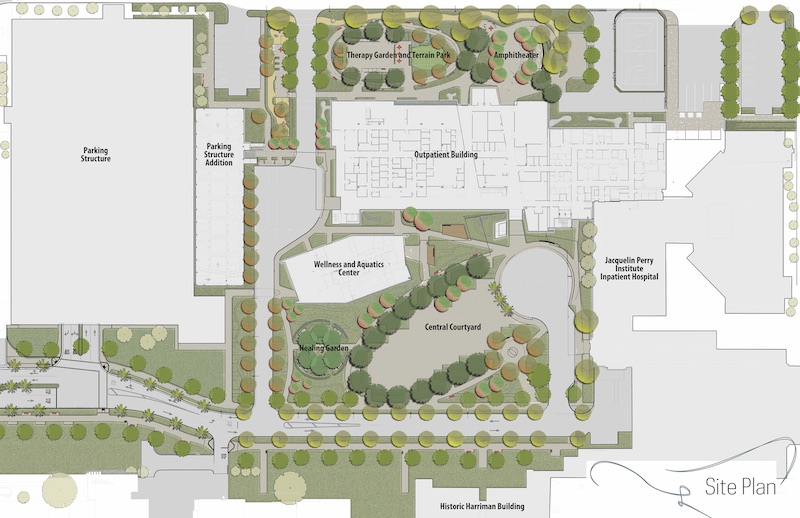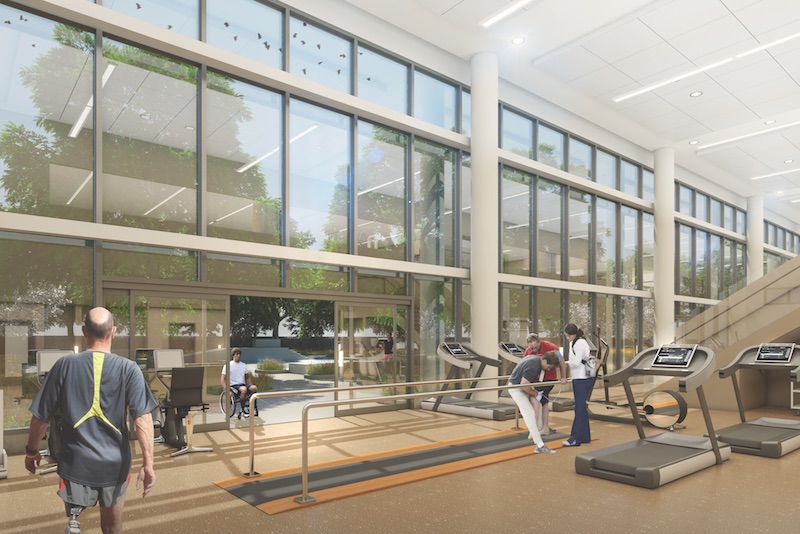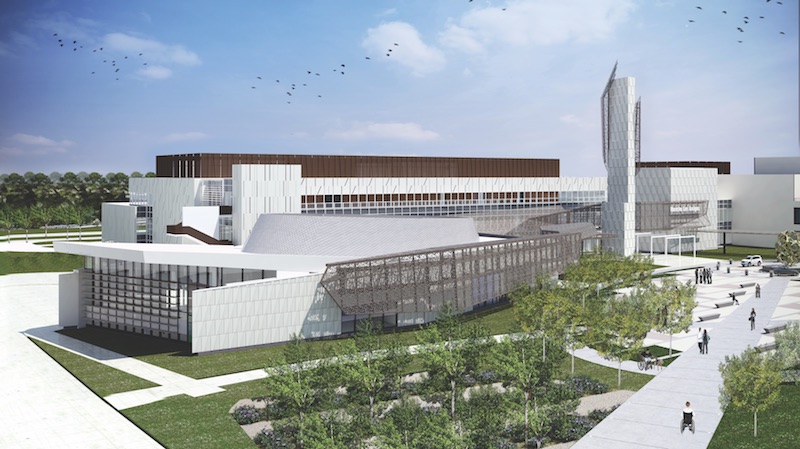The connection between the outdoors, health, and wellness has been gaining validity and acceptance within the design and medical communities. One of the fullest expressions of this nexus is occurring at Rancho Los Amigos National Rehabilitation Center, in Downey, Calif., the renowned recovery and rehab facility for patients with spinal cord and brain injuries, orthopedic disabilities, strokes, neurological disorders, and physical and developmental disorders.
The hospital’s ongoing $418 million revitalization and beautification, which is scheduled for completion in 2020, includes the renovation of its existing inpatient hospital, whose expansion will link it to a new outpatient building. A new wellness and aquatic therapy center already has opened, 15 months ahead of schedule.
But what makes this design-build project different will be the transformation of the facility’s entire campus into an outdoor recovery zone that encompasses a healing garden, therapy gardens, and terrain park.
Bonnie Khang-Keating, Principal and Vice President with SmithGroupJJR, the project’s lead designer, explains that the hospital—which is owned by Los Angeles County and has been in operation since 1888—has been serving the community from mostly older, modular buildings. By stacking those buildings vertically as part of the revitalization, and by adding a parking garage, SmithGroupJJR and Taylor Design, the project’s architect of record, gained considerable open space, which she estimates will account for 30–40% of the total campus.
Existing buildings and hardscape are being replaced with new dual-purpose outdoor spaces, healing gardens and terraces, and large plazas and amphitheaters that will also serve as physical therapy and terrain parks. “The hospital wants to hold events outside, like wheelchair basketball and Special Olympics,” says Khang-Keating.
 SmithGroupJJR and landscape architect KSA Design Studio's layout of the rehab center surrounds new and existing buildings with a variety of outdoor environments. Image: SmithGroupJJR.
SmithGroupJJR and landscape architect KSA Design Studio's layout of the rehab center surrounds new and existing buildings with a variety of outdoor environments. Image: SmithGroupJJR.
Taken together, the 29,170-sf therapy garden, the 8,400-sf horticultural garden, the 21,740-sf amphitheater, and the 8,790-sf sports court will account for 1.56 acres of open space on the hospital premises.
KSA Design Studio, the project’s landscape architect and a member of its design-build team, has focused on selecting the types of plants, ground cover, and other materials that would be used.
Khang-Keating notes that Rancho Los Amigos is unique among hospitals in that all of its outdoor-rehab activities are on the ground floor, which has the benefit of encouraging and expanding patients’ mobility. SmithGroupJJR programmed every foot of outdoor space with the expectation that it would be used every day, says Khang-Keating.
One of the goals of the design is to allow patients to learn to adapt to external conditions they will face once they’re discharged. Many former patients also return to the campus to mentor current patients.
Large sliding doors that line the entire wall of the outpatient therapy gyms further blur the boundary between indoor and outdoor space.
Because landscaping is usually the last thing that gets installed on a project, it can become an afterthought and get reduced or cut completely when budgets get tight.
But Khang-Keating says Rancho Los Amigos championed the indoor-outdoor concept right from the start. She says this is especially true of its CEO, Jorge Orozco, who started working at the hospital as a physical therapist in 1989.
 In the ground-floor gym (below), glass partitions blur the divide between indoors and outdoors. Image: SmithGroupJJR.
In the ground-floor gym (below), glass partitions blur the divide between indoors and outdoors. Image: SmithGroupJJR.
Related Stories
| May 22, 2014
Big Data meets data centers – What the coming DCIM boom means to owners and Building Teams
The demand for sophisticated facility monitoring solutions has spurred a new market segment—data center infrastructure management (DCIM)—that is likely to impact the way data center projects are planned, designed, built, and operated.
| May 21, 2014
Evidence-based design practices for the palliative care environment
Palliative care strives to make patients comfortable as they are receiving treatment for a severe illness. As hospitals seek to avoid Affordable Care Act penalties for poor patient satisfaction, many expect this field to grow quickly.
| May 20, 2014
Kinetic Architecture: New book explores innovations in active façades
The book, co-authored by Arup's Russell Fortmeyer, illustrates the various ways architects, consultants, and engineers approach energy and comfort by manipulating air, water, and light through the layers of passive and active building envelope systems.
| May 20, 2014
Using fire-rated glass in exterior applications
Fire-rated glazing and framing assemblies are just as beneficial on building exteriors as they are on the inside. But knowing how to select the correct fire-rated glass for exterior applications can be confusing. SPONSORED CONTENT
| May 19, 2014
What can architects learn from nature’s 3.8 billion years of experience?
In a new report, HOK and Biomimicry 3.8 partnered to study how lessons from the temperate broadleaf forest biome, which houses many of the world’s largest population centers, can inform the design of the built environment.
| May 14, 2014
Prefab payback: Mortenson quantifies cost and schedule savings from prefabrication techniques
Value-based cost-benefit analysis of prefab approaches on the firm's 360-bed Exempla Saint Joseph Heritage Project shows significant savings for the Building Team.
| May 13, 2014
19 industry groups team to promote resilient planning and building materials
The industry associations, with more than 700,000 members generating almost $1 trillion in GDP, have issued a joint statement on resilience, pushing design and building solutions for disaster mitigation.
| May 11, 2014
Final call for entries: 2014 Giants 300 survey
BD+C's 2014 Giants 300 survey forms are due Wednesday, May 21. Survey results will be published in our July 2014 issue. The annual Giants 300 Report ranks the top AEC firms in commercial construction, by revenue.
| May 7, 2014
Design competition: $900,000 on the line in Las Vegas revitalization challenge
Las Vegas Mayor Carolyn Goodman wants your economic development ideas for remaking four areas within the city, including the Cashman Center and the Las Vegas Medical District.
| May 3, 2014
Health system capital planning for the future: The benefits of master plan portfolio analysis and ambulatory market modeling
Money continues to be scarce, yet U.S. health systems need to invest and re-invest in their physical future. Healthcare facilities planning experts from CBRE Healthcare outline tools and strategies for identifying where to best allocate precious resources.

















